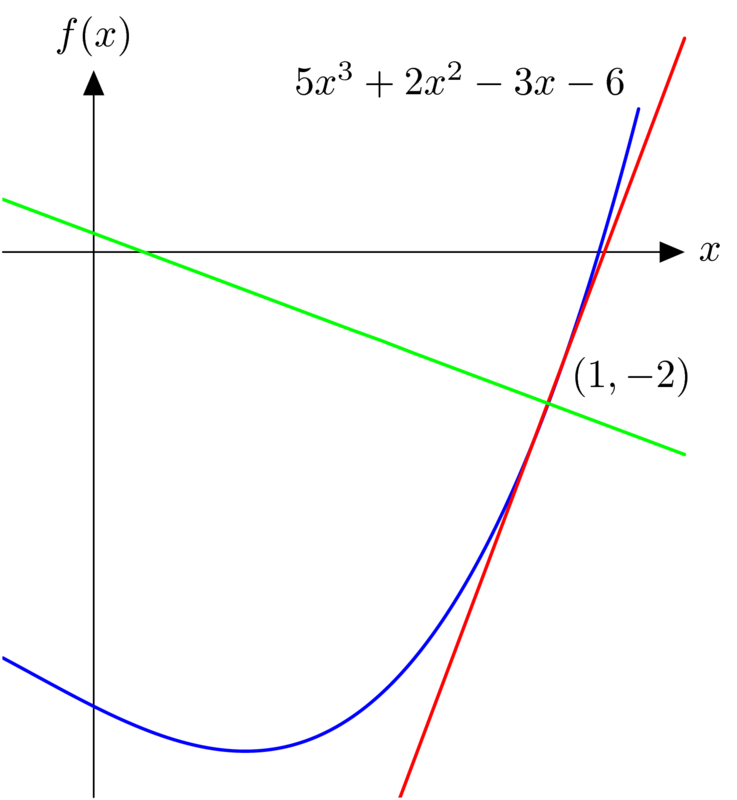Tangents and Normals
Definitions

The Tangent to a Curve
The tangent to a curve at a given point is a straight line which “just touches” the curve at that point. The gradient of the tangent is equal to the derivative of the curve evaluated at the point where the curve and tangent line meet.
For a curve $y=f(x)$, the equation of the line which is tangent to a curve at the point $(x_1,y_1)$ is
\[\frac{y-y_1}{x-x_1}=m\]
From above we know that this is equal to the derivative of the curve at the same point, f'(x_1), so we have:
\[\frac{y-y_1}{x-x_1}=f'(x_1)\]
(note that $y_1 = f(x_1)$)
The Normal to a Curve
The normal to the curve at a particular point is the line perpendicular to the tangent at this point.
If two lines with gradients $m_1$ and $m_2$ are perpendicular to each other, then the product of their gradients is $m_1m_2=-1$.
Thus if a curve $y=f(x)$ has a tangent with (non-zero) gradient $m_1$ at a point $(x_1,y_1)$, the gradient for the normal line at that point is $-\cfrac{1}{m_1}$ and the equation for that normal line is
\[\frac{y-y_1}{x-x_1}=-\frac{1}{m_1}.\]
Since $m_1=f'(x_1)$ this can be rearranged to obtain
\[y=f(x_1)-\frac{x-x_1}{f'(x_1)}.\]
Worked Example
Example 1
Find the equations for the tangent and normal lines to the curve $y=5x^3+2x^2-3x-6$ at the point $(1,-2).$
Solution
Finding the Tangent Line
Recall that the gradient of the tangent line to a curve at a given point $x$ is equal to the gradient of the curve at that point.
Differentiate the equation of the curve to obtain the gradient, $y' = \dfrac{\mathrm{d} y}{\mathrm{d} x}$:
\[\dfrac{\mathrm{d} y}{\mathrm{d} x}=15x^2+4x-3.\]
The gradient $m_1$ at the point $(1,-2)$ is found by evaluating $y'(1)$:
\begin{align} m_1 = y'(1) &= 15 \cdot (1)^2+4 \cdot 1 - 3 \\ &=16. \end{align}
The equation for the line tangent to a curve at a point $(x_1,y_1)$ is given by $\dfrac{y-y_1}{x-x_1} = m_1$.
Here $x_1=1$, $y_1=-2$ and $m_1=16$, so the equation for the tangent line at this point is:
\[\dfrac{y-(-2)}{x-1}=16.\]
This can be rearranged to obtain a solution in the form $y=f(x)$:
\begin{align} \dfrac{y-(-2)}{x-1} &= 16 \\ y+2 &= 16(x-1) \\ y &= 16x-16 -2 \\ y &= 16x-18. \end{align}
The equation for the line tangent to the curve at $(1,-2)$ is
\[y=16x-18.\]
Finding the Normal Line
Let $m_2$ denote the gradient of the line normal to the curve at the point $(1,-2)$. Recall that the gradient of the line tangent to the curve at this point is $m_1=16$.
Since the normal line and tangent line are perpendicular to each other at this point, $m_1m_2=-1$.
The gradient of the normal line is therefore $m_2=-\dfrac{1}{m_1}=-\dfrac{1}{16}$.
The equation for the line normal to a curve at a point $(x_1,y_1)$ is given by $\dfrac{y-y_1}{x-x_1}=m_2$.
Here $x_1=1$, $y_1=-2$ and $m_2=-\dfrac{1}{16}$, so the equation for the normal line at this point is:
\[\dfrac{y-(-2)}{x-1}=-\dfrac{1}{16}.\]
This can be rearranged to obtain a solution in the form $y=f(x)$:
\begin{align} \dfrac{y-(-2)}{x-1} &= -\dfrac{1}{16} \\ y+2 &= -\dfrac{1}{16}(x-1) \\ y &= -\dfrac{1}{16}(x-1)-2 \\ y &= -\dfrac{1}{16}x - \dfrac{31}{16}. \end{align}
The equation for the line normal to the curve at $(1,-2)$ is
\[y=-\dfrac{1}{16}x - \dfrac{31}{16}.\]
Video Examples
Example 1
Prof. Robin Johnson finds the equation of the tangent to the curve $y=2x^3-x^2+3x-1$ at the point $(1,3).$
Workbook
This workbook produced by HELM is a good revision aid, containing key points for revision and many worked examples.
- Applications of differentiation contains a section on tangents and normals.
External Resources
- Tangents and normals workbook at mathcentre